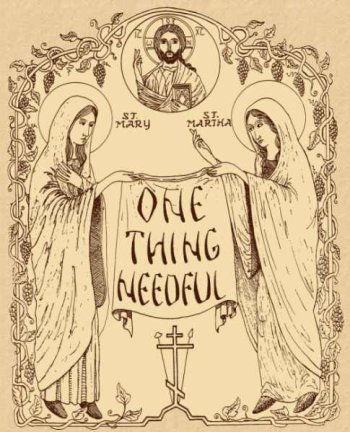
ONE THING NEEDFUL
FALL 2013
BUILDING FUND UPDATE
Often, when we wonder about having begun our monastery building project, we remind ourselves that, if God did not want us to get this far, we would not have been able to start.
So many of you have expressed a happiness for us. Some of you send a note attached to your gift, stating, “I just want a little piece of it.” This brings joy to our hearts and the true knowledge that reminds us that you are cheering us onward. Thank you. Your prayers combined with your gifts have been and continue to be greatly appreciated.
When writing about Saint Euphrosyne in this issue, we started with a woman who is considered a Holy Mother of the Kievan Caves because she was interred there for 700 years. As we researched her life, we learned of her success in building not one, but several monasteries. Of course, it helps if you are of the nobility. But that was the way things were then and there. We are here and now. God works with everyone and every situation.
We continue to ask that if you know someone, or you are that someone, who is interested in the growth of an English speaking women’s monastery in this country, please assist us.
Donations may be sent to:
Saints Mary & Martha Orthodox Monastery
65 Spinner Lane
Wagener, South Carolina 29164

MONASTERY NEWS
Get ready, set, go, wait, finish block work for now, stop, go, clean up work site, start framing, OSHA, regain composure, finish framing roof, cold weather, lay block, need supplies, do what we can, raining, Thanksgiving, well, maybe next week. It’s so hard to be patient. This pretty well sums up our experience with this building project so far.
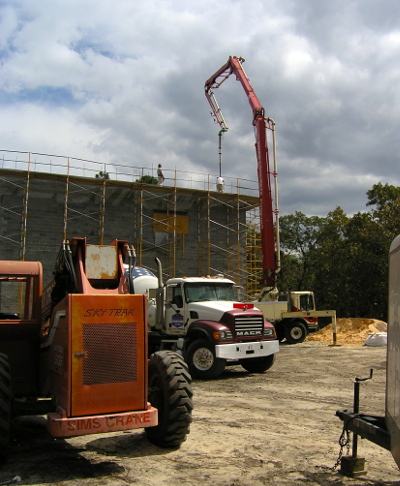

At long last, the block layers finally reached the top. The final four feet were too high for their concrete pump, so a Titan Concrete Pump was rented to fill these courses of block and rebar. From its platform position on the back of a flatbed truck, a man using a remote control directed the Titan, which could reach 30 meters, to release concrete as the block layers guided it into the holes of the concrete block.
It was fascinating to watch, and, even more intriguing to observe two, large, concrete trucks maneuver around the Titan and each other in very limited space.
The picture to the right was taken inside the building facing the north wall of the chapel area which has places for six large windows. The iconostasis will run the width of the chapel between the second and third windows from the right. With the sub-floor in, this was the first time we could actually begin to get a feeling for the interior space.
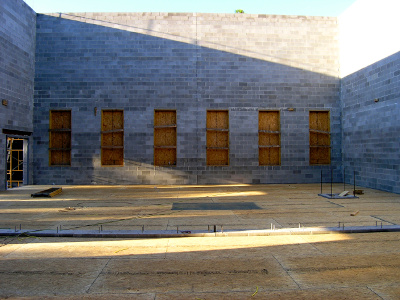
It wasn’t long before the framers had the south side of the central, supporting wall framed (picture to the right), the roof trusses installed, and the roof sheathed and water proofed on the two story side.
Next, they installed three inches of gypsum board as a fire barrier and framed in the chapel side. This wall is designed so that if there is a fire on one side, the wall on the fire side will fall away.
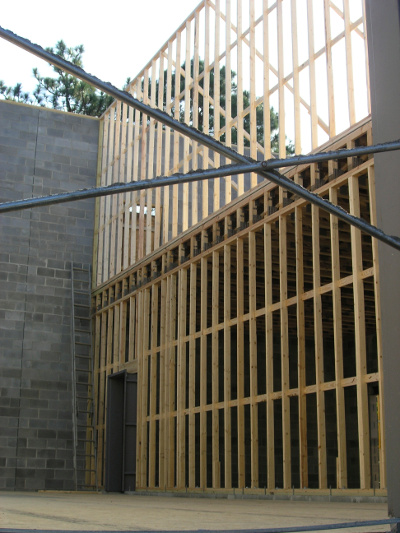
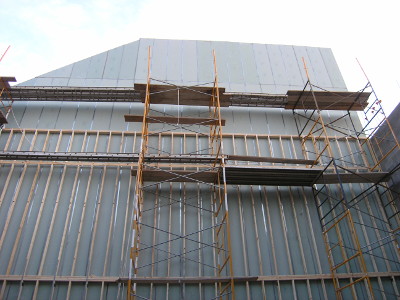
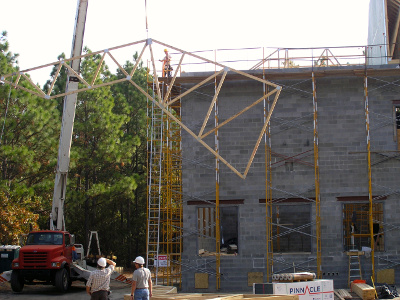
For the second time, a crane was brought in to lift the trusses up to men waiting to install the other half of the roof. As before, the crane was used to lift needed supplies onto the scaffolding so the framers could sheath and water proof this side of the roof.
Shortly after this work was in progress, and they were putting up scaffolding in the chapel, a representative from OSHA notified our contractor that he had instructions to inspect our work site. As a whole, things went well. He was impressed by how clean the work site was, cut the plug off an extension cord that wasn’t grounded, and noted several other items which were corrected immediately. All of us offered up prayers to God in thanksgiving that things went as smoothly as they did and that He had made us safety conscious. We are constantly praying that God keep those working on this project safe.
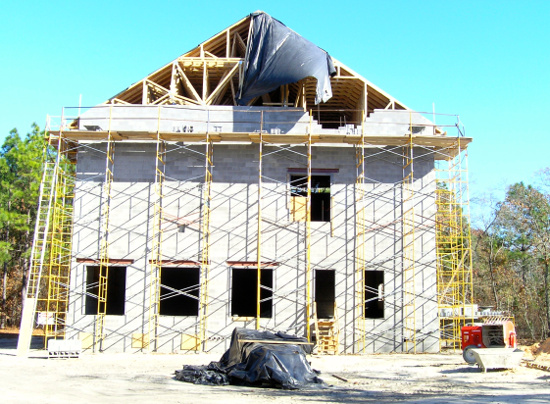
The picture
to the left
shows where
the block
layers are
currently.
We hope to
have a lift
this week
to finish
the firewall.
With rain in the forecast, a huge, black, plastic sheet was used to keep the gypsum board dry. After another week of hammering, etc., the framers pulled off and the block layers returned to finish the west fire wall, work on the sun room, and build the pillars for the stairwell. First one thing and then another and another occurred. Well, that was two weeks ago. Maybe this portion will be finished by the end of the first week in December. One thing is for sure -- everything happens in God’s time.
Over the last few months, we have had a number of people join us in worship and help us with the many chores that are always part of any monastery. There were volunteers from Holy Ascension Orthodox Church in Mt. Pleasant, South Carolina, Holy Cross Orthodox Church in High Point, North Carolina, and Saint John the Wonderworker Orthodox Church in Atlanta, Georgia. A number of individuals also made time to help with various tasks. One mother/daughter team painted the three crosses at the Crosses Garden which had been cleaned up the day before by a woman who was staying with us for a few days.
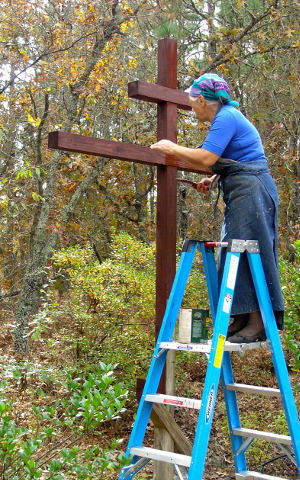
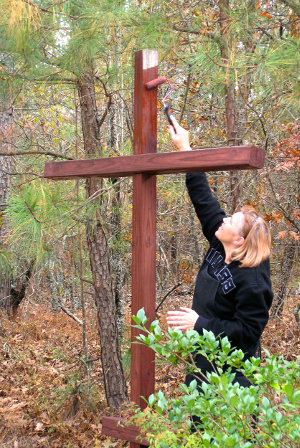
On August 10th, Mother Helena celebrated 55 years in the monastic life. May God grant her many healthy years.
Not having a cat since the end of January and realizing that our rodent population was not being kept under control by the snakes, we started looking for a Manx Cat without a tail. Not finding a grown Manx, a friend of a friend had a four-month old Manx-mix who needed a home. At the end of August, Mancini, a grey and white feline, came to live with us. It was obvious from the outset that he needed a playmate. Still wanting a Manx or Manx mixture, we found a kitten rescuer who had a tailless grey kitten, but she was too young and would not be ready for adoption for a few weeks. So we waited. A week before Clergy Wives Retreat, Makiko came to live with us. Mancini was overjoyed at having a playmate. Makiko took to the monastery with the fearlessness of a born adventurer. They have provided us and our visitors with entertainment and laughter. The two cats have become best friends. Corelli and Laufey, the dogs, easily adjusted to having cats again. Now we have Mancini and Makiko of Saints Mary and Martha Monastery.
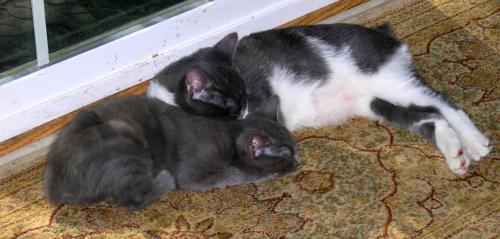
On the fourth Thursday of September, we host the Clergy Wives Retreat. While we do not have a group picture, we do have a picture of three of them checking out the new building. The camaraderie among these women is delightful. On Sunday, the retreat closed with Divine Liturgy which was served by Fr. Peter Smith from Saint Mary of Egypt Orthodox Church in Norcross, Georgia. With there just being two of us since Mother Lyubov’s repose, our weariness was rather evident, and knowing that they loved coming here for retreat, the clergy wives went out of their way to help us. We were most grateful for this.
God knows what we can handle. With a late freeze and excessive rain rotting crops, there is no pear wine or grape wine this year. This much rain filled up the aquifers, one being our water source.
On Tuesday, October 1st, Marina joined us. Now there are three of us again. She is adjusting to the monastic life here.
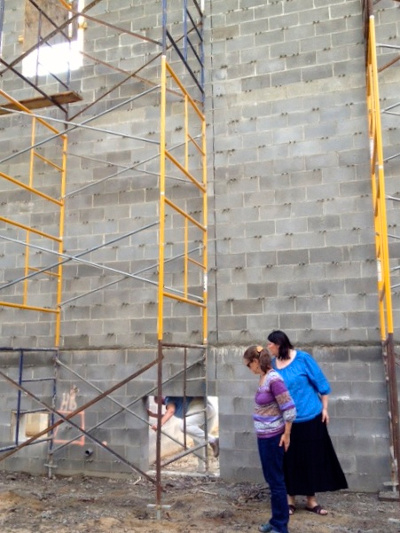
Saturday, October 12th, was Fall Flea Market day. The pace was slower than usual due to the South Carolina State Fair taking place at the same time. The three of us sold more than we thought, $245.25 worth.
In the Saint Joseph’s Candle Shop, we are blessed with a third set of willing hands as well as two friends who have been helping us with candle making since Mother Lyubov fell asleep in our Lord. Candle orders grow and multiply, but we manage to fill them in a timely manner, with God’s help.
The blessings and grace that God continually bestows on us, the strength and patience that He gives us to endure sorrow, loss, and tribulation, the thankfulness for here and all that goes with here, the assuredness that He is the One Who is truly in control, and the love He gives us by which He teaches us to love, for all this and more, we are truly grateful.

HOLY MOTHERS
OF THE KIEVAN CAVES
Saint Euphronsyne of Polotsk (May 23rd)
Saint Juliana Olshanskaya (July 6th & October 10th)
Sant Dosithea (September 25th)
The legacy of the Kievan Caves (founded c. 1051) is one of asceticism and spiritual warfare, a total dedication to the One God in Trinity. Although the members of the Caves were predominantly men, their legacy also includes some women. So honored were the saints of the Kievan Caves that many Russian Orthodox Christians desired to be buried in this heavenly sanctuary. Three renowned women saints were Euphrosyne of Polotsk, Juliana Olshanskaya and Dosithea. The first two “mothers” of the Kievan Caves were not members of the monastic community, but were buried in or near the churches within the Kiev Pechersk Lavra - Caves Monastery in the Ukraine. The third, Saint Dosithea, was a great ascetic who contributed much to the revival of Russian monasticism.
Saint Euphrosyne of Polotsk
(May 23rd)
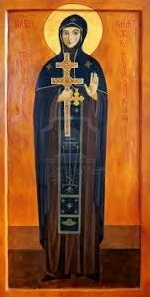
Born into the noble Rurik linage in 1110, Princess Predislava (later named Euphrosyne) was the daughter to Svyatoslav-George, Prince of Vitebsk (in present day Belarus), granddaughter of Prince Vseslav (Usiaslau) the Sorcerer, Prince of Polotsk (Polacak), great-granddaughter of Bryachislav, Prince of Polotsk, great-great-granddaughter of Izyaslav, Prince of Polotsk, and great-great-great-granddaughter of Saint Vladimir the Great, Equal-to-the-Apostles and Rogneda of Polotsk. Throughout her young life Predislava fervently applied herself to her studies which included the Holy Scriptures, the writings of the Church Fathers, history, music, sewing, and many other subjects. Upon hearing her parents making plans for her marriage at twelve years of age, Predislava fled to a monastery where the Abbess Romana, her aunt, lived. Predislava successfully pleaded with her to receive her into the monastery. Before her parents could find her, Predislava was quickly instructed in the monastic life, tonsured and robed a nun, and given the name Euphrosyne. A short time later, Euphrosyne received permission from the Bishop of Polotsk and began living a solitary life in a cell at the Cathedral of Holy Wisdom (Sophia) which her grandfather had finished in 1066. While immersing herself in prayer and fasting, she copied books, sold them, and gave the proceeds to the sick and needy.
In time, Euphrosyne was joined by her sister, Gradislava (Eudokia in the monastic life) and other young, aristocratic women most of whom were related to her. One of the most notable women who brought all her wealth to the monastery was Zvenislava, a princess of Borisov. Upon being fully professed, Zvenislava was given the name Eupraxia. Euphrosyne became the spiritual mother and abbess of this growing number of nuns.
An angel appeared to Euphrosyne, instructed her to build a monastery for virgins, and showed her where it was to be built. Bishop Elias of Polotsk also had the same experience, whereupon, he gave her the land to build the Monastery and the Church of the Transfiguration (c. 1150). (It still stands to this day and is considered the finest example of Polotsk architecture of the twelfth century.)
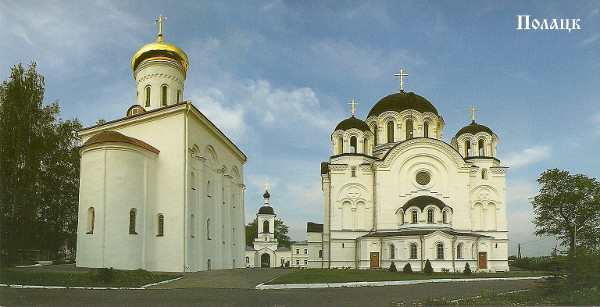
Later the Abbess Euphrosyne had a church and monastery for men built, and bestowed upon it the Hodigitria of Polotsk (Our Lady of Korsun) icon that had been given to her by Emperor Manuel I & Patriarch Michael II when she visited Constantinople. (This icon was a hand-painted reproduction of the original icon painted by Saint Luke the Evangelist.) Bishop Elias entrusted Euphrosyne with the task of founding and organizing women’s monasteries, one of which was in Seltse (now in present day Russia).
Saint Euphrosyne strove to heal the animosity that had existed between the Polotsk and Kiev principalities as they had become rivaling trade centers that battled for land and power. She contributed to the restoration of the Cathedral of Holy Wisdom and recorded some of the events of her day in the Polotsk Chronicles. Her most artistically unique contribution became known as The Cross of Saint Euphrosyne of Polotsk. In 1161, she commissioned Lazar Bohsa, a master jeweler to adorn a six-pointed, cypress cross, about 20” high, with gold, gemstones, and enamel icons. The miniature, enamel icons were of Christ, the Theotokos (Mary), John the Forerunner, the Four Evangelist, Archangels Gabriel and Michael, and the patron saints of her parents and herself. Holy relics were contained within this cross which was kept at The Transfiguration Church in Polotsk until it was relocated to Smolensk in the 13th century. There it remained until the cross was returned to Polotsk in 1841. Under the Soviets, it became a nationalized art object, taken to Minsk in 1928, placed in Mogilev Regional Museum, and disappeared in the summer of 1941 during the German advance of World War II. Had it not been that extensive photographs were taken in 1896, we would not have a replica of St. Euphrosyne’s Cross made by the master jeweler Nikolai Kuzmich in 1997. This cross was consecrated and entrusted to the Transfiguration Monastery for women that Euphrosyne had built in Polotsk.
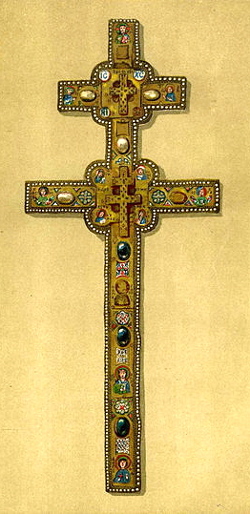
In 1173, Abbess Euphrosyne entrusted her monastery in Polotsk to Mother Eudocia before traveling to Jerusalem with relatives. Knowing who Abbess Euphrosyne was, King Amaury I (King of Jerusalem from 1163-1174) and the Frankish patriarch, welcomed her. Falling ill after visiting the Holy Sepulchre of Christ and being told by an angel of her coming repose, she asked her brother to bring her water from the Jordan which she drank and poured on herself. Having a great admiration for Saint Theodosius the Cenobiarch who assisted and succeeded Saint Anthony of the Kievan Caves in founding Kiev Pechersk Lavra - Caves Monastery, Euphrosyne made arrangements to be buried among the righteous women who were interred at the Jerusalem Cenobium of Saint Theodosius. She received communion and fell asleep in our Lord on May 23, 1173. After Saladin conquered Palestine and took Jerusalem in 1187, her relics were translated and entombed in the Annunciation Church of the Far Kievan Caves. In 1909 the town's people of Polotsk received permission from Tsar Nicholas II to transfer Euphrosyne’s relics to her native city where she is still revered as one of their patron saints. During Bright Week (the week after Orthodox Easter) of 1910, multitudes of the faithful gathered along the route as her relics were carried from Kiev to Polotsk. Among this assemblage of people was Saint Elizabeth the Grand Duchess, Grand Duke Konstantine Constantinovich, and Olga Constantinovna of Russian, wife of King George I of Greece. (To Be Continued)
Butler’s Lives of the Saints Volume II April-May-June, Edited by Herbert J, Thurston, S.J., and Donald Attwater, Christian Classics, Westminster, Maryland, 1990, pgs.377-78.
The Prologue from Ochrid Part Two: April-May-June, by Bishop Nikolai Velimirovic, Translated by Mother Maria, Lazarica Press, Birmingham, Great Britain, 1989, pgs.255-6.
The Synaxarion: The Lives of the Saints of the Orthodox Church Volume Five May, June, by Heiromonk Makarios of Simonos Petra, Translated by Mother Maria (Rule) and Mother Joanna (Burton), Holy Convent of the Annunciation of Our Lady, Ormylia, Greece, 2005, pgs.255-6.
http://prabook.org/web/person-view.html?profileId=721034
http://orthodoxstamp.wordpress.com/tag/euphrosyne-of-polotsk/
http://www.belarus.by/en/about-belarus/famous-belarusians/euphrosyne-of-polotsk
http://www.roca.org/OA/115-116/115u.htm



Saturday Liturgy Schedule
December 14th at 9 am
January 11th at 9 am
February 1st at 9 am
March 1st at 9 am
Matins starts at 8 am.
Knitters Retreat
February 7th & 8th
Contact Maria Floyd: 803-599-4404
OR e-mail her at mariajfloyd@gmail.com
This retreat is for women 21 years of age and older.
Due to limited space, we can only accommodate twelve women.
You need to have a project or projects that you can work on
without help from other knitters.

FROM MARTHA’S KITCHEN
Cinnamon pinwheels
Preheat oven to 450° F. and grease a cookie sheet.
Pastry Ingredients
3 cups flour
1 teaspoon salt
1 cup shortening or butter
8 to 10 tablespoons cold water
In a bowl put flour and stir in the salt. Cut shortening/butter into flour with a pastry blender or dinner fork till it forms lumps smaller than “pea-sized”. Add cold tap water a tablespoon at a time and knead until it forms a unified ball of dough. Be careful not to over knead as this will cause the dough to be tough. Divide dough in half. Wrap the dough ball not being used in plastic wrap and set aside. Lightly flour surface being used to roll out dough. Roll out dough to pie crust thickness, about one-eighth on a inch.
Filling
1 cup sugar
2 teaspoons cinnamon
½ stick of margarine or butter
Combine sugar and cinnamon in a bowl. Spread half the mixture over the dough leaving a half inch around the edge. Cut margarine/butter into chocolate chip size pieces and drop a piece every inch or so. Roll the dough length wise, pinch the ends together, cut 1 to 2 inch slices, and place on the greased cookie sheet. Spoon the excess filling on top of the pinwheels. Repeat process with the other ball of dough.
Bake for 10 minutes or until a light golden color.
Place upside down on a cooling rack. After cooling,enjoy.








